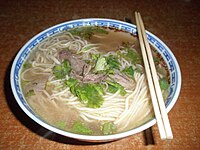Beef noodle soup
 | |
| Type | Noodle soup |
|---|---|
| Region or state | East Asia and Southeast Asia |
| Main ingredients | Beef, beef broth, vegetables, Chinese noodles |
| Beef noodle soup | |||||||||||||||||||||||||
|---|---|---|---|---|---|---|---|---|---|---|---|---|---|---|---|---|---|---|---|---|---|---|---|---|---|
| Traditional Chinese | 牛肉麵 | ||||||||||||||||||||||||
| Simplified Chinese | 牛肉面 | ||||||||||||||||||||||||
| Literal meaning | Beef noodles | ||||||||||||||||||||||||
| |||||||||||||||||||||||||
Beef noodle soup is a noodle soup made of stewed or braised beef, beef broth, vegetables and noodles. It exists in various forms throughout East and Southeast Asia.
One of the oldest beef noodle soups is the Lanzhou lamian (蘭州拉麵) or Lanzhou beef noodle soup which was created by the Hui people of northwest China during the Tang dynasty.[1][2] There are numerous beef noodle soups available in China with a higher variety in the west than the east.[citation needed]
Another common variety is the red-braised beef noodle soup (紅燒牛肉麵) from Taiwan, which was first created by Sichuanese Kuomintang veterans;[3][4] it is commonly known as Taiwanese beef noodle soup in English.
Other beef noodle soup varietals include Pho from Vietnam.
East Asian varieties
[edit]
Lanzhou beef noodle soup
[edit]Lanzhou beef noodles are the version most commonly seen in mainland China, and are a Chinese Muslim style of beef noodle, also known as clear-broth or consommé-stewed beef noodle (清燉牛肉麵). They often use halal (or qingzhen) meat and contain no soy sauce, resulting in a lighter taste that may be flavoured by salt and herbs. Local lore attributes their creation to Ma Baozi, a Hui Chinese man from Lanzhou.[5] In Lanzhou, capital of Gansu, Lanzhou beef lamian (蘭州牛肉拉麵) is usually served with clear soup and one hand-pulled lamian noodle per bowl. In halal restaurants, only quality local beef from the Southern Yellow cattle (Chinese: 黃牛; lit. 'yellow cattle') prepared by the local halal butcher is used for the beef noodle.[6] Chinese radish and specially cooked spicy oil are also indispensable partners to Lanzhou beef noodles. These ingredients are known as "One Clear, Two White, Three Red, Four Green, Five Yellow" (Chinese: 一清、二白、三紅、四綠、五黃; pinyin: Yī qīng, èr bái, sān hóng, sì lǜ, wǔ huáng), referring to clear soup, white radish, red chili oil, green leek and yellow noodles respectively. In overseas Chinese communities in North America, this food can be found in Chinese restaurants. In Mainland China, a large bowl of it is often taken as a whole meal with or without any side dish.
-
Lanzhou Beef Noodle, with clear soup and hand-pulled noodles
-
Lanzhou-style beef noodle soup with chili oil
Taiwanese beef noodle soup
[edit]Taiwanese beef noodle soup is a noodle soup dish originating from Taiwan. It is sometimes referred to as "Sichuan beef noodle soup" (四川牛肉麵), especially in Taiwan.[7][8] This usage can create confusion, as Sichuan has its own versions of beef noodle soups[9] which may be sold at Sichuanese restaurants under the same name.[10] The beef is often stewed with the broth and simmered, sometimes for hours. Chefs also let the stock simmer for long periods with bone marrow; some vendors can cook the beef stock for over 24 hours. In Taiwan, beef noodle vendors may also have optional, often cold side dishes, such as braised dried tofu, seaweed or pork intestine. Beef noodles are often served with suan cai (Chinese sauerkraut) on top, green onion and sometimes other vegetables in the soup as well.[11]
Southeast Asian varieties
[edit]
In Thailand, kuaitiao nuea pueay is a similar dish of braised beef served with rice noodles.[citation needed]
In Vietnam, Pho is a Vietnamese noodle soup that contains broth, rice noodles called bánh phở, herbs and meat, primarily made with either beef (phở bò) or chicken (phở gà). Bò kho is a beef stew sometimes served with noodles (or bread as an alternative). In Philippines, Beef Mami is very popular and can also be combined with Pares.[citation needed]
Yaka mein is a type of beef noodle soup commonly found in Chinese restaurants in New Orleans. It consists of stewed beef, spaghetti noodles, hard-boiled egg and chopped green onions, with Cajun seasoning, chili powder or Old Bay-brand seasoning.[citation needed]
See also
[edit]- Chinese Islamic cuisine
- Chinese noodles
- Instant noodles
- List of Chinese soups
- List of noodle dishes
- List of soups
- Noodle soup
- Pho
- Ramen
- Taiwanese cuisine
- Bún bò Huế
References
[edit]- ^ Lonely Planet Food, The World's Best Spicy Food, Lonely Planet, 2017
- ^ Nate Tate, Feeding the Dragon: A Culinary Travelogue Through China with Recipes, Andrews McMeel Publishing, 2011
- ^ 四川」牛肉麵其實源自台灣?一窺牛肉麵的背後故事. Liberty Times Net. Liberty Times. 9 October 2017. Retrieved 26 September 2018.
- ^ 焦, 桐. 一碗紅燒牛肉麵,喚醒許多人共同的歷史記憶. 遠見華人 精英論壇. Retrieved 26 September 2018.
- ^ "Recipes of China: Lanzhou Beef Noodle Soup". Archived from the original on 2021-07-29. Retrieved 2018-12-01.
- ^ "Taiwan Food Culture - Niuruo Mian (Beef Noodle)". taiwanfoodculture.net. Taiwan Food Culture News. Archived from the original on 18 December 2013. Retrieved 6 December 2013.
- ^ 台灣講古:翻轉本地口味的"川味"牛肉麵. BBC News. Retrieved 26 September 2018.
- ^ "台灣獨特的川味牛肉麵 發跡六十年後帶動百億商機". Tai Sounds. TaiSounds. Archived from the original on 19 October 2019. Retrieved 19 October 2019.
- ^ Lin, Florence (1986). Florence Lin's Complete book of Chinese noodles, dumplings and breads. Peter LaVigna. New York. p. 43. ISBN 0-688-03796-8. OCLC 12978274.
{{cite book}}: CS1 maint: location missing publisher (link) - ^ "Sichuan noodles at sixty-one SFBA Sichuan restaurants". Hungry Onion. 2017-01-27. Retrieved 2021-07-02.
- ^ "Taipei Beef Noodle Festival: Beef Noodle Tasting". tbnf.com.tw. Taipei Beef Noodle Festival. Archived from the original on 17 May 2011. Retrieved 6 December 2013.



